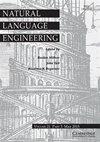Construction Grammar Conceptual Network: Coordination-based graph method for semantic association analysis
IF 1.9
3区 计算机科学
Q3 COMPUTER SCIENCE, ARTIFICIAL INTELLIGENCE
引用次数: 0
Abstract
Abstract In this article, we present the Construction Grammar Conceptual Network method, developed for identifying lexical similarity and word sense discrimination in a syntactically tagged corpus, based on the cognitive linguistic assumption that coordination construction instantiates conceptual relatedness. This graph analysis method projects a semantic value onto a given coordinated syntactic dependency and constructs a second-order lexical network of lexical collocates with a high co-occurrence measure. The subsequent process of clustering and pruning the graph reveals lexical communities with high conceptual similarity, which are interpreted as associated senses of the source lexeme. We demonstrate the theory and its application to the task of identifying the conceptual structure and different meanings of nouns, adjectives and verbs using examples from different corpora, and explain the modulating effects of linguistic and graph parameters. This graph approach is based on syntactic dependency processing and can be used as a complementary method to other contemporary natural language processing resources to enrich semantic tasks such as word disambiguation, domain relatedness, sense structure, identification of synonymy, metonymy, and metaphoricity, as well as to automate comprehensive meta-reasoning about languages and identify cross/intra-cultural discourse variations of prototypical conceptualization patterns and knowledge representations. As a contribution, we provide a web-based app at http://emocnet.uniri.hr/.构建语法概念网络:基于坐标的语义关联分析图方法
摘要在这篇文章中,我们提出了构造语法概念网络方法,该方法是基于协调构造实例化概念关联的认知语言学假设,为识别句法标记语料库中的词汇相似性和词义辨别而开发的。该图分析方法将语义值投影到给定的协调句法依赖上,并构建具有高共现测度的词汇并置的二阶词汇网络。随后对图进行聚类和修剪的过程揭示了具有高度概念相似性的词汇群落,这些词汇群落被解释为源词位的关联意义。我们用不同语料库的例子展示了该理论及其在识别名词、形容词和动词的概念结构和不同含义方面的应用,并解释了语言和图形参数的调节作用。这种图方法基于句法依赖处理,可以作为当代其他自然语言处理资源的补充方法,丰富单词消歧、领域关联、意义结构、同义词识别、转喻和隐喻等语义任务,以及自动化关于语言的综合元推理,识别原型概念化模式和知识表征的跨文化/跨文化话语变体。作为贡献,我们在http://emocnet.uniri.hr/.
本文章由计算机程序翻译,如有差异,请以英文原文为准。
求助全文
约1分钟内获得全文
求助全文
来源期刊

Natural Language Engineering
COMPUTER SCIENCE, ARTIFICIAL INTELLIGENCE-
CiteScore
5.90
自引率
12.00%
发文量
60
审稿时长
>12 weeks
期刊介绍:
Natural Language Engineering meets the needs of professionals and researchers working in all areas of computerised language processing, whether from the perspective of theoretical or descriptive linguistics, lexicology, computer science or engineering. Its aim is to bridge the gap between traditional computational linguistics research and the implementation of practical applications with potential real-world use. As well as publishing research articles on a broad range of topics - from text analysis, machine translation, information retrieval and speech analysis and generation to integrated systems and multi modal interfaces - it also publishes special issues on specific areas and technologies within these topics, an industry watch column and book reviews.
 求助内容:
求助内容: 应助结果提醒方式:
应助结果提醒方式:


